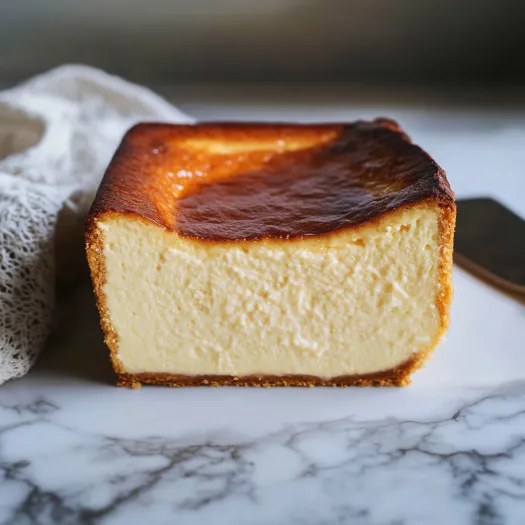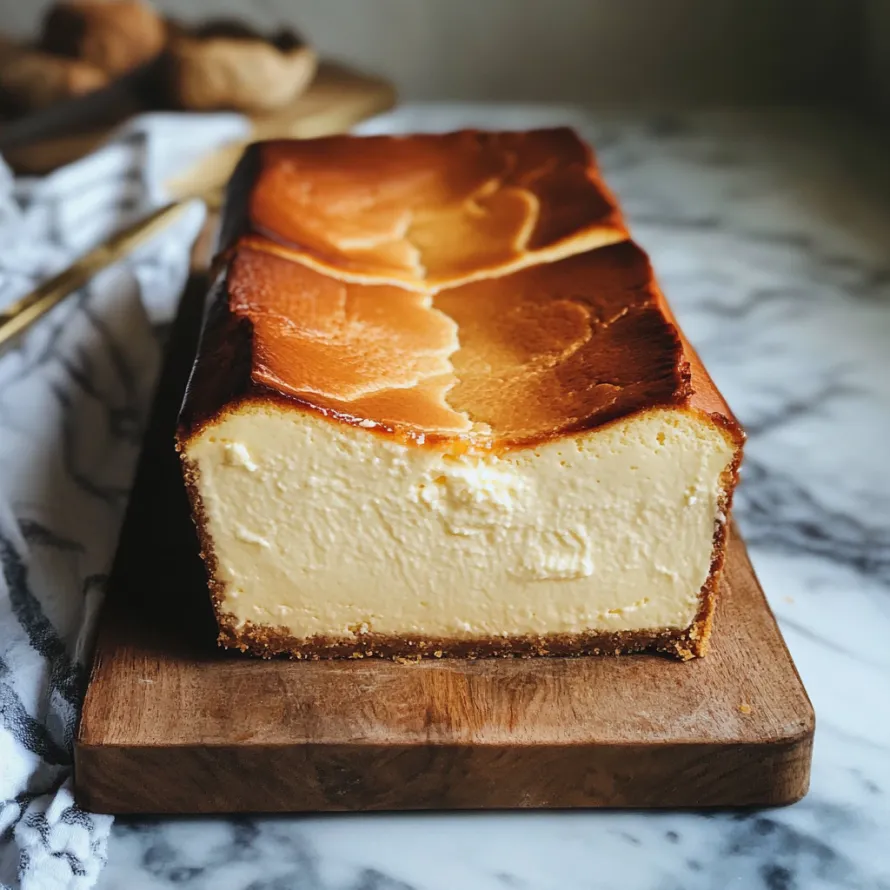 Pin it
Pin it
This country-style Basque cheesecake offers an incredibly smooth interior with a wonderfully brown crusty top. Unlike American-style versions, this European treat doesn't need a fussy water bath or bottom crust yet delivers amazing rich flavor and velvety smoothness. The loaf shape gives you perfect portions with just the right mix of caramelized outer layer and creamy center in every serving.
The first time I made this cheesecake, I couldn't believe I'd wasted so much time with water baths and special pans before. It's so easy to make but tastes so fancy that it works for both Tuesday night treats and dinner parties. The distinctive dark top happens naturally while it bakes, making a beautiful contrast with the light creamy inside.
Key Ingredient Breakdown
Knowing what each ingredient does will help you nail this Basque cheesecake. Go for high-quality, full-fat items for the best taste and texture, and you'll bring everything together without any fuss.
- Full-fat cream cheese: Makes up the rich, tangy base. Always pick the full-fat blocks instead of light or spreadable types for the right texture. Let it sit out about 30 minutes before you start mixing.
- Granulated sugar: Cuts the tang of the cream cheese and helps make that brown top. Regular white sugar works best here.
- Eggs: Hold everything together and make it silky smooth. Warm eggs mix in better, so take them out of the fridge early. Stick with large eggs for best results.
- Heavy cream: Adds that extra richness and helps create the signature smooth feel. You need the high fat content for it to turn out right.
- Vanilla extract: You can skip it, but it adds nice warmth that goes well with the tangy cream cheese. Real vanilla gives the best flavor.
- Salt: Makes all the other flavors pop and balances the sweetness. Sea salt or kosher salt works really well in this.
- All-purpose flour: Just a tiny bit helps the cheesecake stay together without getting heavy. Sift it first, then measure carefully.
How To Make It
A few easy steps will get you that perfect balance of creamy inside and caramelized top. Being careful with your mixing and baking times will give you the best results.
- Warm Up Your Ingredients:
- Start by getting all cold stuff to room temperature. Let cream cheese sit on the counter about 30 minutes before you begin. Cold cream cheese will make your batter lumpy and it won't get properly smooth.
- Mix The Foundation:
- In a big bowl, put your soft cream cheese and sugar. Beat them with an electric mixer on low for a full 5 minutes until they're totally smooth and a bit fluffy. Scrape the bowl sides often to mix everything evenly and get rid of lumps.
- Put In The Eggs:
- Crack each egg into a small bowl first to check for shells, then add them to your cream cheese mix one at a time. Mix well after each egg, letting it blend in completely before adding another. This slow process makes a smoother, more stable batter.
- Make It Silky:
- Pour in the heavy cream, vanilla if you're using it, and salt. Mix on low just until combined, but don't overmix. The batter should pour easily but still have some thickness. Too much mixing now can add too much air and change how it turns out.
- Add The Flour:
- Sift the tablespoon of flour right over your mixture to avoid lumps. Use a rubber spatula to fold it in gently until it just disappears. The flour gives a little structure without making your cheesecake less creamy.
- Baking Steps:
- Lightly grease a standard loaf pan, then line it with parchment paper, leaving extra hanging over the sides so you can lift it out easily later. Pour your smooth batter into the pan, and tap it gently on the counter a few times to get rid of air bubbles.
- Getting That Perfect Brown Top:
- Put your loaf pan on the middle rack of your 400°F preheated oven. Bake for 40-45 minutes until the top turns dark golden brown but the middle still jiggles slightly. When you see deep brown edges with a lighter center, it's done just right.
 Pin it
Pin it
I got hooked on Basque cheesecake after trying it at a little European bakery close to where I live. The owner told me that baking at high heat makes that special brown top that balances out how rich the filling is. Now it's our go-to celebration dessert in my family, taking the place of birthday cake. My daughter asks for it every year and calls it 'fancy toast cheesecake' because of its beautiful golden-brown color.
Delicious Serving Ideas
Let the cheesecake cool all the way before you cut it. Try it with some fresh berries, a light sprinkle of powdered sugar, or a thin drizzle of honey for a classy finish.
 Pin it
Pin it
Keeping It Fresh
Keep your cheesecake in the fridge for up to 5 days, loosely covered with plastic wrap. If you want it to last longer, wrap single slices in plastic and freeze them for up to 3 months. Let frozen slices thaw overnight before eating.
Frequently Asked Questions
- → Can I make Basque cheesecake with reduced-fat cream cheese?
- For the classic creamy result, stick with full-fat cream cheese. Using low-fat might give your cheesecake a thinner texture and less flavor.
- → Why is the Basque cheesecake top so dark?
- The darker top is what makes Basque cheesecake unique. It adds a rich, caramel taste while balancing the creamy inside. It’s not burnt – that’s the signature look!
- → How can I tell if my Basque cheesecake is ready to come out of the oven?
- You’ll know it’s done when the edges are deeply browned and the center still jiggles slightly. It firms up more as it cools.
- → Is it okay to freeze Basque cheesecake?
- Absolutely! Once cooled, wrap it tightly in plastic wrap followed by foil, then freeze. Thaw in the fridge overnight before serving. It lasts up to two months frozen.
- → How’s Basque cheesecake different from regular cheesecake?
- Unlike traditional cheesecake, Basque cheesecake skips the crust, has a caramelized top, and is baked at a hotter temperature. It embraces cracks and has a smoother, softer texture.
